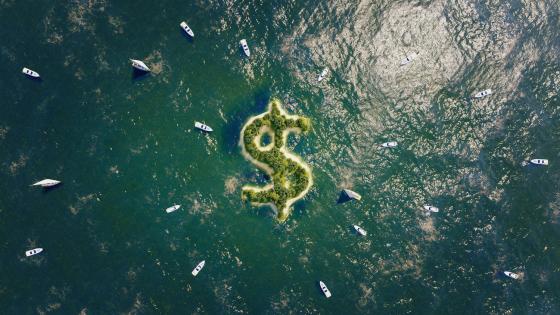When a supernova runs out of energy and begins to collapse, its density may become so great that it prevents light rays from escaping. So the dying star becomes a “black hole” which, though invisible, can be detected by how it distorts the space around it. The black hole is, according to Stephen Hawking, one of the few cases in the history of science when theory was developed in detailed mathematical form before there was any supporting observational evidence.
Collapsing stars and financial contraction
What about economics? Richard Koo’s graphic account of the Japanese economy after its asset bubble burst suggests that there may be black holes here too! The contraction in asset prices unleashed by the bursting of the bubble dragged whole swathes of highly-levered Japanese companies into technical insolvency – with liabilities exceeding assets. Collusion between CEOs and creditors may have concealed the problem hole. But according to Koo, it could be detected by the distortion in corporate spending it caused – and the ‘balance sheet recession’ that followed.
The same balance sheet pressures played a role in East Asian countries in crisis of 1997-8 – compounded by the sharp rise in the value of dollar-denominated debts as their currencies fell against the dollar. What of the crisis of 2007-8 that has threatened the survival of the overblown financial systems of Britain and America?
The current paradigm – and alternative perspectives
Consider first what the current macro paradigm may have to say about this. The canonical New Keynesian/New Classical macroeconomic model (as outlined in Michael Woodford’s Interest and Prices, for example) focuses on using interest rates to control inflation in a setting where the private sector optimises inter-temporally but wages and prices are relatively inflexible. Under the convenient assumption of a representative agent with rational expectations, credit flows and leverage are left out of the picture, however. Assuming a representative agent with rational expectations may have proved an elegant and convenient simplification for normal times. It does, however, effectively rules out asset bubbles, excessive leverage, and financial collapse. In short, it is as if the absence of black holes is the essential prediction of modern macroeconomics!
If financial black holes have been observed, so much the worse for the current paradigm. Are there alternative perspectives? One of these, as Paul Krugman noted in his recent assessment of ”How Did Economists Get It So Wrong?”, is that of Kiyotaki and Moore in their analysis of credit cycles. This iconic model with heterogeneous agents – deep-pocket lenders and high-levered small businesses – and unanticipated macroeconomic shocks implies that there is a substantial risk of collapse – particularly when an asset bubble bursts, as is argued in Miller and Stiglitz (2009).
Figure 1 highlights the contrast between asset price behaviour in normal times and how they respond to unforeseen macroeconomic shocks. In normal times, asset prices and holdings of small business sector head towards equilibrium at E, moving along NN, a stable path whose dynamics are driven by the need for these small businesses to collateralise their borrowing. But in the face of macroeconomic shocks, things move much more quickly – as we find using the dotted lines defining the “initial conditions” when the shock hits. An unexpected – but temporary – technology shock that raises the productivity of all small businesses will, for example, lead to a prompt increase in resources held by the sector and in asset prices, too, as they bid for these resources. This is shown by the intersection of the schedule TT with the stable path at Y (where the rightward shift from E to X is the effect of higher cash flow and the move from X to Y captures the multiplier effect of asset prices). In the absence of further shocks, there will be a gradual return to equilibrium along the stable path.
Figure 1. Normal times – and the impact of macro shocks
These multiplier effects go sharply into reverse for negative shocks, however, and there is the added risk of bankruptcy. It may conventional to talk about negative technology shocks, but consider instead the bursting of an asset bubble, where the bubble itself is represented by the unstable path rising vertically from E. When it bursts, there will of course be a fall in asset prices; but the subsequent “fire sales” by firms trying to pay down debts amplify this downward pressure. This is illustrated by the schedule BB giving the initial condition if the asset bubble collapses when it has reached the point Z. The small business sector avoid bankruptcy survives if BB intersects NN to the right of the line S (indicating the solvency condition where assets exceed the value of debts); but the whole sector will be driven into technical insolvency if, as shown, the initial condition intersects the stable path to the left of S. Why should this matter?
Bankruptcy
With regard to the widespread insolvency in Japan after the bubble burst, Koo (2008) explains that ”if it becomes known that a borrower is technically insolvent, loans extended to the company will become bad loans and the lender will be forced by government regulators to cut off credit, and try to collect on existing loans”. In fact the consequences of technical insolvency were seen to be so severe that the collusive strategy of concealing the true balance sheet position was apparently widespread in Japan.
If assets were “marked-to-market”, however, such a strategy would be difficult to implement. So there is a real risk that collateral arrangements designed to secure the repayment of debt will trigger widespread collapse of highly levered businesses, with resources being transferred wholesale to less productive use elsewhere. The end of an economy-wide asset bubble could then become the economic equivalent of the collapse of a supernova – with the “black hole” of mass insolvency threatening to swallow whole sectors of an over-leveraged economy. Is there no escape?
Rescue operations
When legal provisions for corporate liquidation threaten to prove counterproductive, it is always possible to apply for court-ordered restructuring of debt. In the US, for example, there are procedures for doing this under Chapter 11 of bankruptcy law – added during the Great Depression – that apply in circumstances where the “continuation value” of a business exceeds the value its assets would fetch if sold in the market. But it seems unlikely that law courts working on individual cases can take account of an industry-wide “externality” of the sort considered here. With the courts ignoring the effect of extra fire sales on the value of collateral elsewhere, there will be excessive recourse to outright liquidation.
A collective approach that internalises this externality could surely do better, as argued in Miller and Stiglitz (2009). This is the case for “super Chapter 11” procedures, where the government steps in to assist balance sheet restructuring by arranging for industry-wide capital injections, for example, as implemented by the UK Chancellor of the Exchequer in October 2008. Alternatively, as proposed by Mr Paulson, the government can step in as a buyer of last resort and purchase assets itself, supplying liquidity to prevent asset prices from collapsing. So collective action rather than collusive concealment is the escape route.
Summary
Adding an asset bubble to a canonical model of highly leveraged businesses highlights the vicious downward spiral that may develop when asset prices begin to fall and the emergency measures that may be used to check this – with the government stepping in because of the externalities and moral hazard involved. Emergency action to restore and restructure balance sheets is not unusual in emerging markets facing financial crisis, in Thailand for instance in 1997/8 or more recently in Argentina. But it stands in sharp contrast to the view from conventional models that the effects of a worsening of financial intermediation are likely to be limited and can be handled by interest rate cuts alone.
If the shock is big enough, interest rate policy alone will not pack enough punch to avert collapse. In practice, the monetary authorities may be stymied by “agency” problems as intermediaries fail to intermediate. Besides cutting interest rates as far as they can, the US and UK authorities have undertaken extraordinary financial interventions, amounting in total to around three quarters of GDP – interventions that have more than doubled the size of central bank balance sheets.
A sting in the tail
From cosmological black holes, there is evidently no escape. From the economic equivalent, however, there is! But there is a sting in the tail. Where the problem stems from externalities and distorted incentives in the economy itself, rescues can increase moral hazard. So – unless sufficient energy is dedicated to countering the externalities and distorted incentives –financial rescue operations could (alas!) increase the likelihood of future crises.
References
Kiyotaki, Noburo and John Moore (1997), “Credit cycles”. Journal of Political Economy, vol.105, April, pp.211-248.
Koo, Richard.C. (2008), The Holy Grail of Macroeconomics: Lessons from Japan’s Great Recession, Singapore: J. Wiley.
Krugman, Paul (2009), “How Did Economists Get It So Wrong?” New York Times, 2 September.
Miller, Marcus and Joseph Stiglitz (2009), ‘Leverage and Asset Bubbles: Averting Armageddon with Chapter 11?’ CEPR Discussion Paper 7469.
Woodford, Michael (2003), Interest and Prices, Princeton, NJ: Princeton University Press



